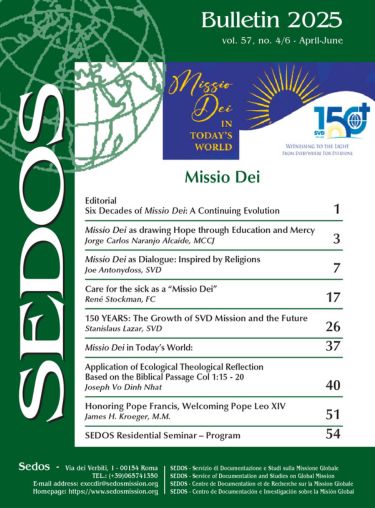Our beloved Pope Francis guided the church for just over twelve years (2013-2025), all filled with intense activity. As the 266th pope, Francis has garnered many “firsts.” He is the first pope to take the name “Francis” in honor of Saint Francis of Assisi; both shared a special love of the poor and needy. Francis’ first pastoral visit outside of Rome was to the island of Lampedusa, one of the nearest gateways to Europe for Africans fleeing poverty and conflict. He is the first pope coming from the Society of Jesus (Jesuits) and the first pope from the Americas.
Francis, clearly a “people’s pope,” has visited at least 60 states and territories on his international trips, traveling about 255,000 miles. In addition, he is the first pope to visit the Arabian Peninsula, birthplace of Islam. Francis led the church of 1.4 billion (over one-sixth of the world’s population). In his late-2024 visit to Asia, he covered over 20,000 miles (32,000 kilometers). He has canonized over 900 saints, including Mother Teresa of Calcutta and martyred Salvadoran Archbishop Oscar Romero.
Additional Facts. Francis has issued a variety of major documents, including four encyclicals: Lumen Fidei (2013) [faith], Laudato Sí (2015) [environment], Fratelli Tutti (2020) [social fraternity], and Dilexit Nos (2024) [Sacred Heart]. He has published seven apostolic exhortations, the first being Evangelii Gaudium (2013) [Joy of the Gospel], encouraging us to be active “missionary disciples.” His writings include the 2015 papal bull on mercy, Misericordiae Vultus, where he describes Jesus as “mercy made flesh.” He has personally attended three World Youth Days (Brazil, Poland, and Panama). He wisely governed the church during the Covid-19 pandemic.
Council Affirmation. However, one remarkable “achievement” which is not included in these many statistics is that during his pontificate, Pope Francis canonized three popes: John XXIII, Paul VI, and John Paul II. In the mind of this author, it is significant that all these three “pope-saints” were active participants in Vatican II. Thus, one could validly assert that Pope Francis has not simply canonized three “Vatican II Popes”; he has also canonized the legacy of the Second Vatican Council.
Remarkably, Pope Francis is the first pope in six decades who did not personally participate in Vatican II. He had his formation during the Council, having entered the Jesuits in 1958, the same year that Pope John XXIII, the “Father of Vatican II,” became pope; he was ordained in 1969, soon after the Council concluded. He has remarkably assimilated the spirit and vision of this marvelous, Spirit-inspired event. With Francis, the Council is almost as alive today as it was sixty years ago when it concluded in 1965. One can identify several core Council themes clearly reflected in the life and teaching of this popular pope.
Foundational Principles. First, Vatican II gave attention to collegiality, the principle that all bishops, together with the pope, have responsibility for the church. This guideline intends to promote a participatory church, an involved People of God. Francis further expands this vision with his emphasis on synodality, which is a readiness to enter into dynamic, respectful, and prayerful speaking, listening, and dialoguing, following the Holy Spirit’s lead. Francis successfully concluded two international gatherings on synodality, involving all members of the church, in 2023 and 2024.
A second Council emphasis focuses on the local church. This vision was highlighted in the Council document on missionary activity, Ad Gentes. In short, the “center of action” is the local church; this principle extends to liturgy, evangelization, episcopal conferences, leadership, as well as numerous other areas of Christian life. Full, active, conscious participation in church life is both a right and duty of all the baptized; Francis sought to concretize this vision in all local churches around the world.
Additional Guidelines. Vatican II emphasized the importance of dialogue. This word was introduced into the Council by Paul VI, another Vatican II “saint-pope” in his encyclical Ecclesiam Suam (1964) [His Church]. This broad principle emphasizes that the church is to be a community of dialogue, not monologue, a truly listening church, hearing voices from within the church, from other Christians, from people of other faiths, and from the world at large. Francis proved to be a superb example of open-hearted listening!
A fourth principle is captured by the popular expression “servant-leadership.” Again, this vision is applicable to all Christians who seek to aid others in their diverse needs. Even if the actual assistance may be rather small, it is the attitude of sensitive compassion that touches the other person’s heart. Truly, Francis embodied Cardinal Newman’s episcopal motto: cor ad cor loquitur, heart speaks to heart.
Profound Appreciation. A short article can only present a sampling of pivotal ways that Francis is truly a Vatican II pope; we have only explored four items. However, underlying various specific items is Pope Francis’ profound sensitivity and deep compassion. We all rejoice in heartfelt gratitude for the marvelous gift of Franciscus!
Leo XIV, Missionary Pope
The 267th leader of the world’s 1.4 billion Catholics, Pope Leo XIV, has numerous qualities and experiences that equip him to be a true leader and father to Church members and all peoples of faith and good will. Many of these characteristics are already well-known, thanks to extensive media coverage. However, this short piece wishes to focus on one particular significant quality: his “missionary heart.” Let us begin with a little-known, interesting historical fact; it is drawn from this writer’s own lengthy mission experience in the Philippines, the world’s third largest local Church (after Brazil and Mexico).
Missionary Commitment. Pope Leo XIV is a member of the Order of Saint Augustine (OSA), founded in 1244. Throughout its history the Augustinians have consistently engaged in missionary activity. Ferdinand Magellan arrived in the Philippines in 1521, searching for spices and converts for Spanish King Philip II. Magellan was mortally wounded by Lapulapu, a native chieftain. In a second Spanish expedition in 1565, Miguel Lopez de Legaspi returned to the Philippines; significantly, five Augustinians, originating from Spain and Mexico, were also on board.
An organized program of evangelization was thus begun in 1565, spearheaded by the Augustinians. They were followed by Franciscans (1578), Jesuits (1581), Dominicans (1587), and Augustinian Recollects (1606). Augustinian Fray Andres de Urdaneta retrieved a treasured image of the Santo Niňo (Holy Child Jesus) that had been brought by Magellan. This devotion is one of the largest popular religious expressions in the country; currently, the new pope’s fellow Augustinians care for a minor basilica in Cebu City, the center of this devotion. This unique historical fact confirms that Leo XIV belongs to an order with a deep and profound “missionary heart.” In fact, Pope Leo has been to the Philippines a number of times.
Missionary Heart. This first Augustinian pope possesses numerous additional qualities that reflect his heart for mission. Leo himself has extensive mission experience, working in Peru for over twenty years. He labored in a remote area, often trudging through the rain and mud to meet the needs of the poor and those on the margins of society. He has also served the Diocese of Chiclayo, a region on the peripheries including 1.3 million people with 83% Catholics that is prone to heavy rains and flooding. Leo was known for his hands-on pastoral care, being deeply involved in social justice and programs of community support. Such experiences result in a deep personal transformation of one’s person, of one’s heart.
Pope Leo XIV is known as a polyglot. Apart from his native English, he is fluent in Spanish, Italian, French and Portuguese. With his academic background, he would know Latin and German. Presumably, he also learned elements of Quechua, the local language in parts of the Chiclayo region. Missionaries know from direct experience that learning another language is not only a matter of vocabulary and grammar; one begins to imbibe the world-view, values and culture of the local people speaking that language. In addition, often one effectively learns the local language through memorizing and singing local songs. These experiences, with both successes and blunders, transform one’s values and one’s heart.
Social Awareness. Commentators have noted the great significance of the pope’s choice of name: Leo, following Pope Leo XIII (1878-1903). He is best remembered for his 1891 encyclical, Rerum Novarum (new realities). This document was written at the time of the industrial revolution, which brought many new challenges to numerous people. It enunciated the rights of workers, the need to fight injustice, seek just wages, and assist victims of all forms of abuse. This pivotal document set the Church’s social teaching on a firm basis. One can realistically expect Leo XIV to both continue and expand this tradition, especially in the areas of social justice and environmental concerns.
Having a “missionary heart” means that one builds upon the foundations and labors of earlier missioners. Clearly, it is expected that Pope Leo will build upon many of Pope Francis’ initiatives and successes. One immediately thinks of synodality, dialogue, bridge-building, gospel joy, care for migrants and refugees, and international travel to visit local churches around the world. Pope Leo prayed at the tomb of Pope Francis on May 10 on his first visit outside the Vatican. Earlier that same day, Leo spoke of Pope Francis, telling the assembled cardinals: “Let us take up this precious legacy and continue on the journey.”
Fostering Unity. Pope Leo has chosen as his papal motto: In illo uno unum (In the one Christ we are one). This choice speaks of his desire for unity in the Church. It also follows the teaching of Saint Augustine and the Augustinians, emphasizing love, harmony, humility and dedication to the spiritual community of the Church. Our new pope is only sixty-nine years old; thus, we hope to enjoy many fruitful years of his leadership, missionary insight, and dedicated pastoral service!



